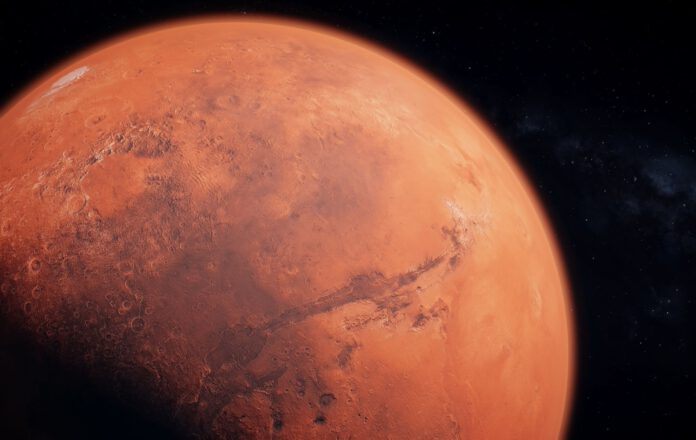
Mars Encounter with Massive Internal Tectonic Movement
The record-breaking seismic event experienced on Mars most likely did not result from a meteorite impact, but rather from vast tectonic movements within the crust of the red planet.
On the night of May 4, 2022, while Mars was cloaked in darkness, the seismometer on board the Mars InSight lander recorded a powerful quake. It quickly became clear that this Marsquake was far and away the strongest extraterrestrial quake ever detected. The quake registered 4.7 on the Richter scale and caused vibrations that echoed through the planet for at least six hours. Researchers have since been trying to determine precisely how this mysterious and record-breaking event occurred. Finally, they have discovered the cause.
Insight’s Seismic Finds
In 2018, the Mars InSight lander placed a seismometer on the Martian surface shortly after landing on the red planet. During its operational life, the seismometer has recorded hundreds of quakes. However, the Marsquake that occurred in May of the previous year is quite extraordinary.
The event, known as S1222a, exceeded all previous quakes with a 4.7 on the Richter scale. The energy released equaled the energy of all previous Marsquakes combined. Although the event happened over 2000 kilometers away from InSight, the waves it registered were so intense that the seismometer nearly overloaded.
Considering Meteorite Impact
In a recent study, researchers attempted to trace the origin of the most potent Marsquake ever recorded. Their initial thought was that a meteorite impact might have caused it. This assumption arose because the seismic signal resembled earlier quakes known to be caused by meteorite impacts. InSight has recorded at least eight such Marsquakes during its lifetime. The two biggest of these resulted in craters approximately 150 meters in diameter.
The Hunt for a New Crater
If a meteorite impact caused S1222a, the team assumed it would likely have left a crater at least 300 meters wide. Therefore, they began the search for a new crater on Mars. They pored over the data from various Mars satellites to seek a new crater or any other conspicuous evidence of impact, such as a dust cloud that could have appeared a few hours after the quake.
Collaboration
Regrettably, the search proved challenging, an unsurprising fact considering the size of Mars. Although Mars is smaller than Earth, it has roughly the same land area, mainly because it lacks oceans. To investigate this immense area of 144 million square kilometers, the study’s leader, Benjamin Fernando, solicited contributions from the European Space Agency, the China National Space Administration, the Indian Space Agency, and the United Arab Emirates Space Agency. This collaborative effort marked the first time all missions joined forces on a single project. “This project represents a significant international effort to solve the S1222a puzzle, and I am immensely grateful for the contributions from all missions,” Fernando stated.
Reflecting on the Tectonic Forces
After several months of futile crater searching, it seems that the heaviest Marsquake ever recorded was not due to a meteorite impact. Instead, the shock was likely due to enormous tectonic forces inside Mars. This finding suggests that the planet is seismically more active than initially thought.
Understanding Mars From Its Core
This insight means we are beginning to understand more about Mars’s interior. Marsquakes could potentially result from sudden shifts in the crust. This phenomenon, however, differs from Earth, where earthquakes are typically caused by the movement of tectonic plates forming the Earth’s surface. The surface of Mars is not composed of plates. “We still believe that Mars does not have active plate tectonics,” says Fernando. “We therefore believe it’s likely that S1222a was a result of the release of built-up tension within Mars’s crust, tensions that have accumulated over billions of years of evolution, where various parts of the planet cooled and shrunk at different speeds. We still don’t fully understand why some parts of Mars experience more tension than others, but findings like this contribute to our understanding.”
S1222a was one of the last events InSight recorded before the mission ended in December 2022. Researchers are elated they could witness this remarkable event. Fernando hopes the study’s findings will prove valuable in the future. “One day, this information might come in handy to determine where it would be safe for humans to live on Mars and which areas you might want to avoid,” he concludes.











